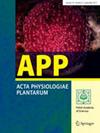Melatonin supplementation alleviates drought stress in peach (Prunus persica) seedlings by improving photosynthesis, root morphological traits, and antioxidant defense system
Abstract
Plant yield and productivity are being impacted significantly by global climate change. Since water scarcity is one of the main risks to agriculture's future, developing plants that can withstand water stress is crucial. The peach is an essential fruit crop for examining how plants respond to drought stress, which lowers crop performance through yield and quality losses. Melatonin, a versatile, beneficial stress-relieving hormone, can be used to alter how plants respond to environmental stresses. The current investigation examined how melatonin may improve early peach seedlings' resistance to drought stress. Our findings revealed a significant decrease in plant biomass and photosynthetic activity and increased oxidative damage under drought stress. Melatonin application promotes plant development and reduces oxidative damage by increasing photosynthetic activity and chlorophyll contents. Melatonin also increases soluble sugars and proline contents. Furthermore, an increase in the activities of superoxide dismutase (SOD), catalase (CAT), peroxidase (POD), and ascorbate peroxidase (APX) was also recorded in peach seedlings. According to the results of our investigation, melatonin applied at a concentration of 100 µM had the highest effect on increasing plant survival under drought stress and contributed to the development of a practical approach for peaches under drought stress conditions.


 求助内容:
求助内容: 应助结果提醒方式:
应助结果提醒方式:


